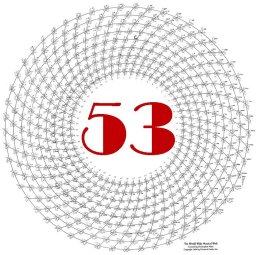Next Page: 14/2 – Is Tonality Finished?
Modal Modulation
People who had never heard of, or cared about, the originals cried “sacrilege”: “The classics are ours. Leave the classics alone.” To them all my answer was and is the same: You “respect,” but I love. –Stravinsky’s response to his detractors when he began composing in his “neoclassical” style
Here is where things get really interesting. We have already explored over 300 ancient scales and modes, which we can now play almost perfectly in tune in 53-eq. Many of these ancient modes were created in cultures where modulation was unheard of. For traditional cultures like India and China especially, changing out the pitch of the tonic or Om note would mean a radical shift in or destruction of the entire cosmic order. One of the many reasons I have chosen the 53-eq palette and not pure Just Intonation is 53-eq’s ability to merge the harmonic purity of the ancient scales and the transformational power of the European classical modulatory tradition.
By gaining mastery of modal modulation, you will be able to discover what is common between any two scales from anywhere in the world, and exploit those commonalities to leap freely from culture to culture, key to key. This is a technique perfected in the 12-eq realm by Allaudin Mathieu in Chapter 40 of Harmonic Experience, but it has even more uses in 53-eq. What he has shown is that the principles of finding notes in common in traditional major/minor modulations apply rather well to the ancient modes in their original tunings. In 53-eq, we can add a few tweaks to deal with some juicy microtonal moves along the way.
I do modal modulation all the time in my 53-eq music, jumping from mode to mode, changing tonal centers, even leaping from culture to culture. I have decided that as a 21st century composer, I will develop and exploit 21st century musical techniques. So while I borrow from and love the ancient musical cultures, I am no more interested than Stravinsky was in simply apprenticing myself to a single tradition. If you wish to stay absolutely true to the great ancient traditions, find the one you most resonate with. Play their instruments and sing their songs, learning the original tunings and modes and melodies and rhythms from a teacher. You don’t need the 53-eq template to do this. But if you are interested in creating a meta-musical style where all the ancient musical traditions of the world can blend in perfect harmony, you need 53-eq. You may be saying goodbye to the more static elements of the ancient traditions. Traditionalists will not always embrace this new musical language, any more than they embraced the neoclassicism of Stravinsky. Some will say I am doing another kind of violence to the ancient traditions: instead of merely playing these ancient modes out of tune as 12-eq performers do, I am mish-mashing them together in ways that the ur-composers would find horrifying. But the discovery of a Universal Translator of all of ancient music is a major part of my musical direction, and is not about the simple preservation of one ancient musical culture or another…
This is the chapter where I use musical examples and outline the technique of moving from ancient mode to ancient mode, modulating modes that have never been modulated in their pure original tunings before, etc. I also play two examples of full-scale compositions where I use modal modulation extensively: one with ancient Indian modes, and another with music of St Augustine’s time. If you would like to learn more about how to do this and much more in 53-equal tuning, you can buy the entire book, The Grand Unified Theory of Music, in pdf form for $25 with hundreds of embedded musical examples of scales and chords from all over the world.
A free introduction to what The Grand Unified Theory of Music offers is on this website and includes both text and a few musical examples from each webpage. If you would like to learn more about this chapter and the full contents of this entire e-book, you can buy The Grand Unified Theory of Music for $25, with hundreds of embedded musical examples of scales and chords from all over the world — and ideas for how to set up your computer system —
HERE.
You’ll get a personalized password you can use to see the entire e-book. Inside the full book, you will also get a link to the complete pdf file of this e-book, which you can read on your Kindle or similar device. The links to the hundreds of mp3 sound files – the same ones you can hear on the website — will also be included. This is “Version 1.0” of The Grand Unified Theory of Music. Because it is an e-book, additions, corrections and improvements in the sound may be added at any time. The Grand Unified Theory of Music is Copyright © 2018 by Christopher Mohr. All rights reserved.
One person per password. Sharing this password with others is a violation of copyright. Do not allow others to use your password or link to the pdf file!
